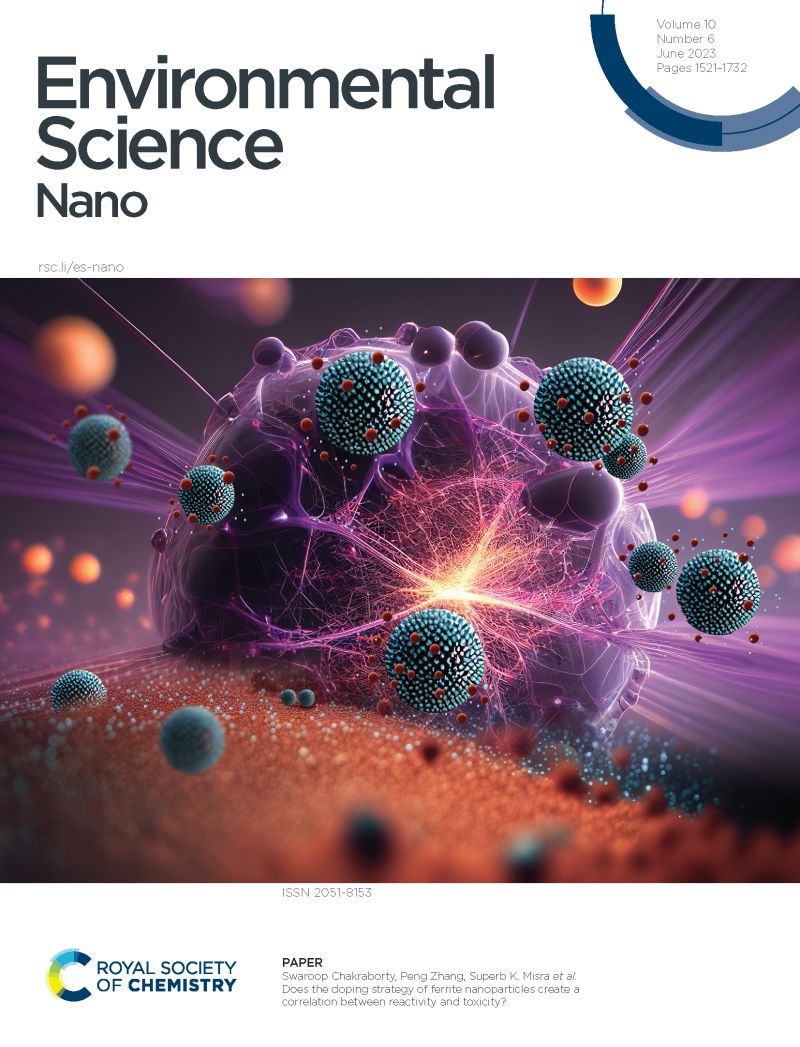掺铕和掺钙的二氧化钛纳米晶体:调整黑腹果蝇的生物相容性和发光可追溯性
IF 5.8
2区 环境科学与生态学
Q1 CHEMISTRY, MULTIDISCIPLINARY
引用次数: 0
摘要
我们通过掺杂铕(Eu)离子(TiO2:Eu)引入红色发光来探索二氧化钛纳米晶体(NCs)。我们的目标是通过钙(Ca)共掺杂优化其生物相容性和发光性能。为此,我们合成了纳米材料,并通过研究二氧化钛晶相对掺杂、形态、ZETA电位、流体力学直径和光催化性能的影响进行了物理表征。我们使用人骨肉瘤细胞(SAOS-2)进行了细胞毒性体外试验,并使用黑腹果蝇进行了体内试验,评估了纳米材料在胚后发育过程中的死亡率以及在体内的发光情况。我们的研究结果表明,钙离子成功地融入了 TiO2:Eu 晶体(TiO2:Eu:xCa)结构中,没有出现其他相或化合物。掺杂钙离子后,光催化活性降低了约 70%。此外,掺杂 Ca 对 SAOS-2 细胞没有细胞毒性。我们的体内分析表明,胚后发育没有延迟,也没有幼虫或蛹死亡。当果蝇接触浓度为 1 毫克/毫升或更低的纳米材料时,其幼虫死亡率和蛹形成率与对照组相当。共聚焦显微镜图像中检测到了 NCs 的发光,表明幼虫的大脑和肠道中存在 NCs。在掺铕和掺钙的二氧化钛(TiO2:Eu:xCa)中也观察到了这种发光现象。这些结果表明,掺杂钙提高了这些材料的生物相容性并增强了其发光能力,使其在生物组织中具有可追溯性。因此,我们的研究为TiO2的定制特性在生物医学各领域的潜在应用提供了宝贵的见解。本文章由计算机程序翻译,如有差异,请以英文原文为准。
Europium and Calcium-Co-Doped TiO2 Nanocrystals: Tuning the Biocompatibility and Luminescent Traceability of Drosophila melanogaster
We explored the TiO2 nanocrystals (NCs) by introducing red luminescence via europium (Eu) ion doping (TiO2:Eu). Our objective was to optimize their biocompatibility and luminescence through calcium (Ca) co-doping. To achieve this, nanomaterials were synthesized, and physical characterizations were performed by investigating the effects of the crystalline phase of TiO2 on the doping, morphology, zeta potential, hydrodynamic diameter, and photocatalytic properties. Biological assessments were conducted using in vitro assays with human osteosarcoma cells (SAOS-2) through cytotoxicity assays and in vivo assays with Drosophila melanogaster, where we evaluated the mortality rate during postembryonic development and the luminescence of nanomaterials in vivo. Our results demonstrated the successful integration of Ca ions into the TiO2:Eu crystal (TiO2:Eu:xCa) structure without the emergence of additional phases or compounds. The co-doping of Ca led to a reduction of approximately 70% in photocatalytic activity. Moreover, co-doping with Ca was not cytotoxic to SAOS-2 cells. Our in vivo analysis showed no delays in postembryonic development and no larval or pupal lethality. The larval mortality rate and pupal formation rate were comparable to the control group when Drosophila were exposed to nanomaterials at concentrations of 1 mg/mL or lower. Luminescence of the NCs was detected in confocal microscopy images, indicating the presence of NCs in the larval brain and intestines. This luminescence was observed in Europium and Calcium-Co-Doped TiO2 (TiO2:Eu:xCa). These results showed that Ca doping improved the biocompatibility and enhanced the luminescence of these materials, making them traceable in biological tissues. Therefore, our research provides valuable insights into the tailored properties of TiO2 for potential applications in various fields of biomedicine.
求助全文
通过发布文献求助,成功后即可免费获取论文全文。
去求助
来源期刊

Environmental Science: Nano
CHEMISTRY, MULTIDISCIPLINARY-ENVIRONMENTAL SCIENCES
CiteScore
12.20
自引率
5.50%
发文量
290
审稿时长
2.1 months
期刊介绍:
Environmental Science: Nano serves as a comprehensive and high-impact peer-reviewed source of information on the design and demonstration of engineered nanomaterials for environment-based applications. It also covers the interactions between engineered, natural, and incidental nanomaterials with biological and environmental systems. This scope includes, but is not limited to, the following topic areas:
Novel nanomaterial-based applications for water, air, soil, food, and energy sustainability
Nanomaterial interactions with biological systems and nanotoxicology
Environmental fate, reactivity, and transformations of nanoscale materials
Nanoscale processes in the environment
Sustainable nanotechnology including rational nanomaterial design, life cycle assessment, risk/benefit analysis
 求助内容:
求助内容: 应助结果提醒方式:
应助结果提醒方式:


